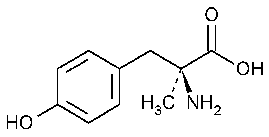Metyrosine
»Metyrosine contains not less than 98.6percent and not more than 101.0percent of C10H13NO3,calculated on the dried basis.
Packaging and storage—
Preserve in well-closed containers.
Identification—
A:
Infrared Absorption á197Mñ.
B:
Ultraviolet Absorption á197Uñ—
Solution:
15µg per mL.
Medium:
0.1Nhydrochloric acid.
Absorptivities at 224nm,calculated on the dried basis,do not differ by more than 3.0%.
Specific rotation á781Sñ:
between +185 and +195
and +195 (t=30
(t=30 ;l=546nm;l=0.5dm).
;l=546nm;l=0.5dm).
Test solution:
5mg per mL,in Diluent,with the aid of sonication if necessary.Prepare the Diluentas follows.
Solution A—
Dissolve 20.0g of anhydrous sodium acetate in about 150mLof water in a 250-mLvolumetric flask.Add 50.0mLof glacial acetic acid,dilute with water to volume,and mix.
Solution B—
Dissolve 62.5g of cupric sulfate in water in a 200-mLvolumetric flask,dilute with water to volume,and mix.
Diluent—
Mix Solution Aand Solution Bin a 1000-mLvolumetric flask,dilute with water to volume,and mix.
Loss on drying á731ñ—
Dry it at a pressure not exceeding 5mm of mercury at 100 for two hours:it loses not more than 1.0%of its weight.
for two hours:it loses not more than 1.0%of its weight.
Residue on ignition á281ñ:
not more than 0.1%.
Heavy metals,Method IIá231ñ:
0.003%.
Organic volatile impurities,Method IVá467ñ:
meets the requirements.
Chromatographic purity—
Standard solutions—
Dissolve USP Metyrosine RSin a solvent mixture of methanol and ammonium hydroxide (7:3)to obtain a solution having a concentration of 10mg per mL(Standard solution A).Pipet 1mLof Standard solution Ainto a 100-mLvolumetric flask,dilute with the same solvent mixture to volume,and mix (Standard solution B).Pipet 5mLof Standard solution Binto a 10-mLvolumetric flask,dilute with the same solvent mixture to volume,and mix (Standard solution C).Pipet 5mLof Standard solution Cinto a 10-mLvolumetric flask,dilute with the same solvent mixture to volume,and mix (Standard solution D).
Test solution—
Dissolve Metyrosine in the solvent mixture of methanol and ammonium hydroxide (7:3)to obtain a solution having a concentration of 10mg per mL.
Procedure—
Apply 10-µLportions of Standard solutions A,B,C,and Dand the Test solutionto a suitable thin-layer chromatographic plate (see Chromatography á621ñ)coated with a 0.25-mm layer of chromatographic silica gel mixture and previously washed with methanol.Allow the spots to dry,and develop the chromatogram in a solvent system consisting of a mixture of n-propyl alcohol and ammonium hydroxide (7:3)until the solvent front has moved about three-fourths of the length of the plate.Remove the plate from the developing chamber,mark the solvent front,and dry the plate.Expose the plate to iodine vapors,and examine under short-wavelength UVlight:the chromatogram shows principal spots at about the same RFvalue.Estimate the levels of any additional spots observed in the chromatogram of the Test solutionby comparison with the spots in the chromatograms of Standard solutions B,C,and D:the sum of the intensities of any spots observed is not greater than that of the principal spot obtained from Standard solution B,corresponding to not more than 1%.
Assay—
Dissolve about 300mg of Metyrosine,accurately weighed,in about 100mLof glacial acetic acid,sonicate for about 5minutes,and titrate with 0.1Nperchloric acid VS,determining the endpoint potentiometrically,using a platinum ring electrode and a sleeve-type calomel electrode containing 0.1Nlithium perchlorate in glacial acetic acid (see Titrimetry á541ñ).Perform a blank determination,and make any necessary correction.Each mLof 0.1Nperchloric acid is equivalent to 19.52mg of C10H13NO3.
Auxiliary Information—
Staff Liaison:Andrzej Wilk,Ph.D.,Senior Scientific Associate
Expert Committee:(PA5)Pharmaceutical Analysis 5
USP28–NF23Page 1289
Phone Number:1-301-816-8305
